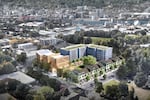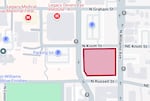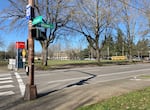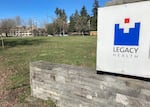A long-vacant block on Portland’s North Russell Street and North Williams Avenue, which was once one of the epicenters of a thriving Black community, will finally house people once again.
The corner was razed in the early 1970s as part of an urban renewal project to make way for a hospital expansion that never occurred. The proposed expansion of what was then Emanuel Hospital led to the demolition of more than 300 homes and businesses in the predominantly Black neighborhood.
Today, about 50 years later, construction will begin on a new development there with an 85-unit apartment building, 20 single-family homes and office and retail space for Black-owned businesses. The project will be finished by 2028.
The groundbreaking comes nearly a decade after Legacy Health agreed to hand over the property for development. In 2017, the city’s urban renewal agency, Legacy Health and then-Mayor Ted Wheeler announced a project to develop the property.
Bryson Davis, the president of the nonprofit behind the project, Williams & Russell CDC, and Anyeley Hallová, CEO and founder of the real estate development company, Adre, joined OPB’s “Think Out Loud” to discuss the project.

EDIT: A provided rendering shows the planned development at North Russell Avenue and North Williams Street, a long-vacant, 1.7-acre parcel razed in the 1970s as part of an urban renewal project that displaced home and business owners in Northeast Portland. Development plans include 85 affordable units, 20 homes for ownership, and a 30,000-square-foot Black Business Hub.
Courtesy of Williams & Russell CDC
The following are highlights from the conversation edited for length and clarity.
What this block meant to Portland’s Black community in the 1940s, 1950s, 1960s
Bryson Davis: It was the center of business, the center of the community, the center of the neighborhood … this was the middle of the Black community at the time.
What urban renewal meant for this block
Davis: You had a lot of tweaking things and labeling things as blights in ways that diminished people’s property values, and then they could condemn them, underpay them for the value of their property and move them out. And so it was really a tool that you could use to turn a neighborhood that was composed in a way that you didn’t necessarily want it to be composed, and adjust things and move people to other places and then underpay them for the things that you took from them.
How the project to develop it started
Davis: [The city and the hospital] came together in the mid 2010s, when the city discovered, “Hey, you were supposed to do something with this land, and you haven’t,” and the arrangement that came to was, “Why don’t we give this property back to the community? Put together a project working group of community members, nonprofit leaders and local activists to figure out what we should put on the property and then go from there.”
What makes this development project different from others
Anyeley Hallová: I think the community is kind of dealing with the trauma that comes with displacement and gentrification. I wanted to make sure that I put together a team that really could serve the community and think of the community’s priorities first and foremost, and I knew not every developer in town was going to be thinking with that mindset and really thinking about Black leaders in the community being a part of this team in all aspects.
What community members who had been displaced wanted from this project
Davis: Housing — but people didn’t want just affordable apartments. They wanted some opportunity for ownership … The theme was really wealth creation, because what was taken was really the family wealth of the people who were underpaid and were displaced. Entrepreneurial support was a big key thing and so that had to be a part of the project. And another thing that was really lost was having a central place for people to gather, having that community space.
Hallová: We actually did workshops with potential Black home buyers to really think about the preferences they have for the style of home … We didn’t want to build a project to which the community said, “This is not meeting our needs.” And so we actually changed the whole entire design of the townhomes based on community feedback that we received … We really saw that potential home buyers really want larger homes. They want the feeling of a single family home, even though that’s very hard to make affordable now. So we went away from a more condo-stacked-unit style to individual townhomes. There was a huge preference on backyards, and so we made sure each home had a substantial backyard. So really we took the idea of privacy and single-family-home feeling and put it into a townhouse development.
How the Black-owned business hub will work
Hallová: There’s a micro-retail space that we’re going to use for newer retail people, as well as micro-office space. There’s going to be regular-size office space for some businesses, but one of the things that we’re really emphasizing is getting in some of these nonprofits that support minority-owned businesses in there and have a presence, so you can go there, get help with business financing, … get help with navigating government systems and things like that.
Who will be able to live there
Davis: Because we have the Fair Housing Act, there are legal restrictions on how you can go about selling and renting out homes. That led to the preference policy, which is what we’re using for both the rental and the townhomes that we’ll sell. We’re trying to address the harm of the hospital expansion and that directly connects the people going into the homes to that harm.
Bryson Davis and Anyeley Hallová spoke with “Think Out Loud” host Dave Miller. Click play to listen to the full conversation:






